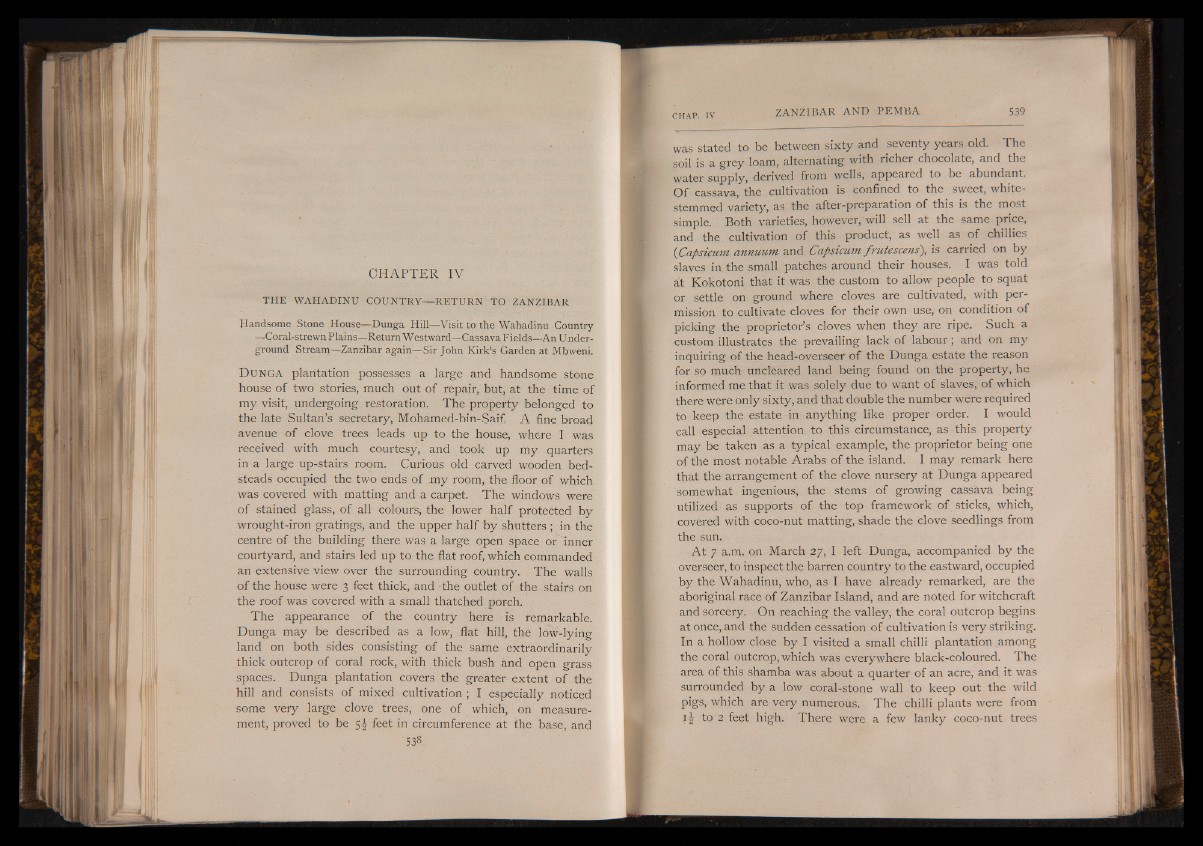
CHAPTER IV
THE WAHADINU COUNTRY— RETURN TO ZANZIBAR
Handsome Stone House— Dunga Hill— Visit to the Wahadinu Country
—Coral-strewn Plains—Return Westward—Cassava Fields—An Under-
ground Stream— Zanzibar again— Sir John Kirk’s Garden at Mbweni.
DUNGA plantation possesses a large and handsome stone
house of two stories, much out of repair, but, at the time of
my visit, undergoing restoration. The property belonged to
the late Sultan’s secretary, Mohamed-bin-Saif. A fine broad
avenue of clove trees leads up to the house, where I was
received with much courtesy, and Took up my quarters
in a large up-stairs room. Curious old carved wooden bedsteads
occupied the two ends of my room, the floor of which
was covered with matting and a carpet. The windows were
of stained glass, of all colours, the lower half protected by
wrought-iron gratings, and the upper half by shutters ; in the
centre of the building there was a large open space or inner
courtyard, and stairs led up to the flat roof, which commanded
an extensive view over the surrounding country. The walls
of the house were 3 feet thick, and the outlet of the stairs on
the roof was covered with a small thatched porch.
The appearance of the country here is remarkable.
Dunga may be described as a low, flat hill, the low-lying
land on both sides consisting of the same extraordinarily
thick outcrop of coral rock, with thick bush and open grass
spaces. Dunga plantation covers the greater extent of the
hill and consists of mixed cultivation ; I especially noticed
some very large clove trees, one of which, on measurement,
proved to be 5^ feet in circumference at the base, and
538
was stated to be between sixty and seventy years old. The
soil is a grey loam, alternating with richer chocolate, and the
water supply, derived from wells, appeared to be abundant,
Of cassava, the cultivation is confined to the sweet, whitestemmed
variety, as the after-preparation of this is the most
simple. Both varieties, however, will sell at the same price,
and the cultivation of this product, as well as of chillies
{Capsicum annuum and Capsicum frutescens), is carried on by
slaves in the small patches around their houses. I was told
at Kokotoni that it was the custom to allow people to squat
or settle on ground where cloves are cultivated, with permission
to cultivate cloves for their own use, on condition of
picking the proprietor’s cloves when they are ripe. Such a
custom illustrates the prevailing lack of labour; and on my
inquiring of the head-overseer of the Dunga estate the reason
for so much uncleared land being found on the property, he
informed me that it was solely due to want of slaves, of which
there were only sixty, and that double the number were required
to keep the estate in anything like proper order. I would
call especial attention to this circumstance, as this property
may be taken as a typical example, the proprietor being one
of the most notable Arabs of the island. I may remark here
that the arrangement of the clove nursery at Dunga appeared
somewhat ingenious, the stems of growing cassava being
utilized as supports of the top framework of sticks, which,
covered with coco-nut matting, shade the clove seedlings from
the sun.
A t 7 a.m. on March 27, I left Dunga, accompanied by the
overseer, to inspect the barren country to the eastward, occupied
by the Wahadinu, who, as I have already remarked, are the
aboriginal race of Zanzibar Island, and are noted for witchcraft
and sorcery. On reaching the valley, the coral outcrop begins
at once, and the sudden cessation of cultivation is very striking.
In a hollow close by I visited a small chilli plantation among
the coral outcrop, which was everywhere black-coloured. The
area of this shamba was about a quarter of an acre, and it was
surrounded by a low coral-stone wall to keep out the wild
pigs, which are very numerous. The chilli plants were from
1^ to 2 feet high. There were a few lanky coco-nut trees